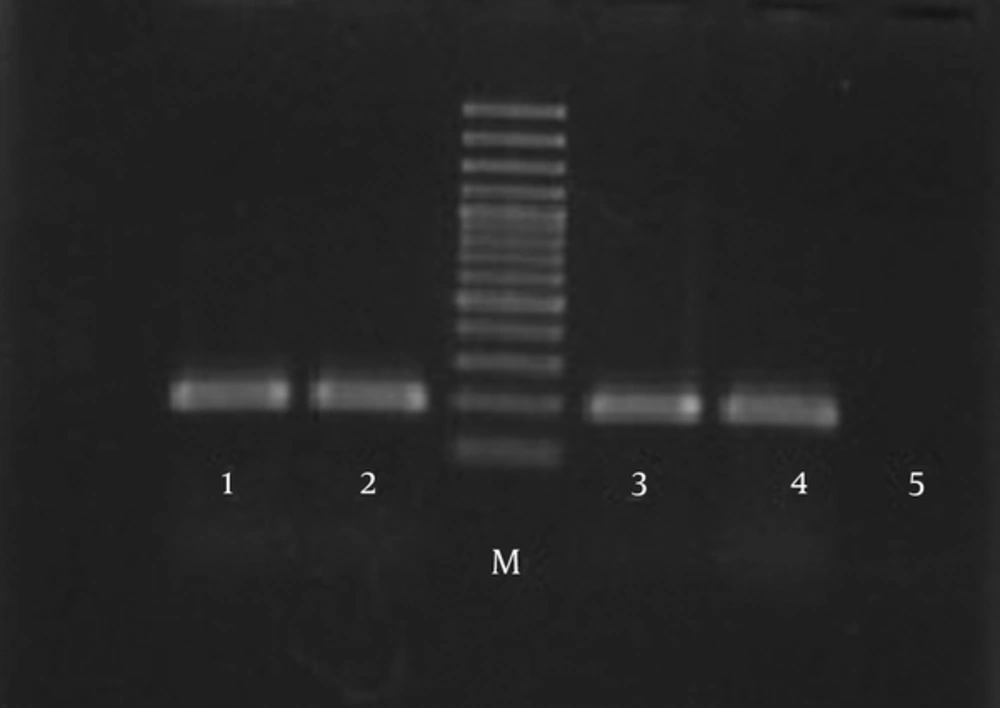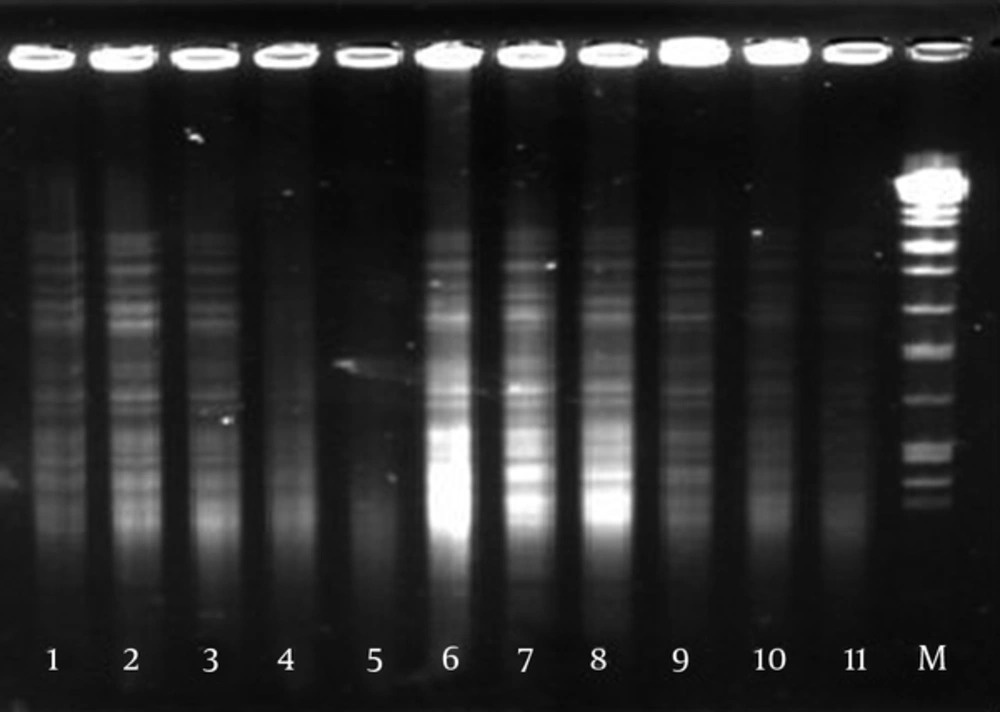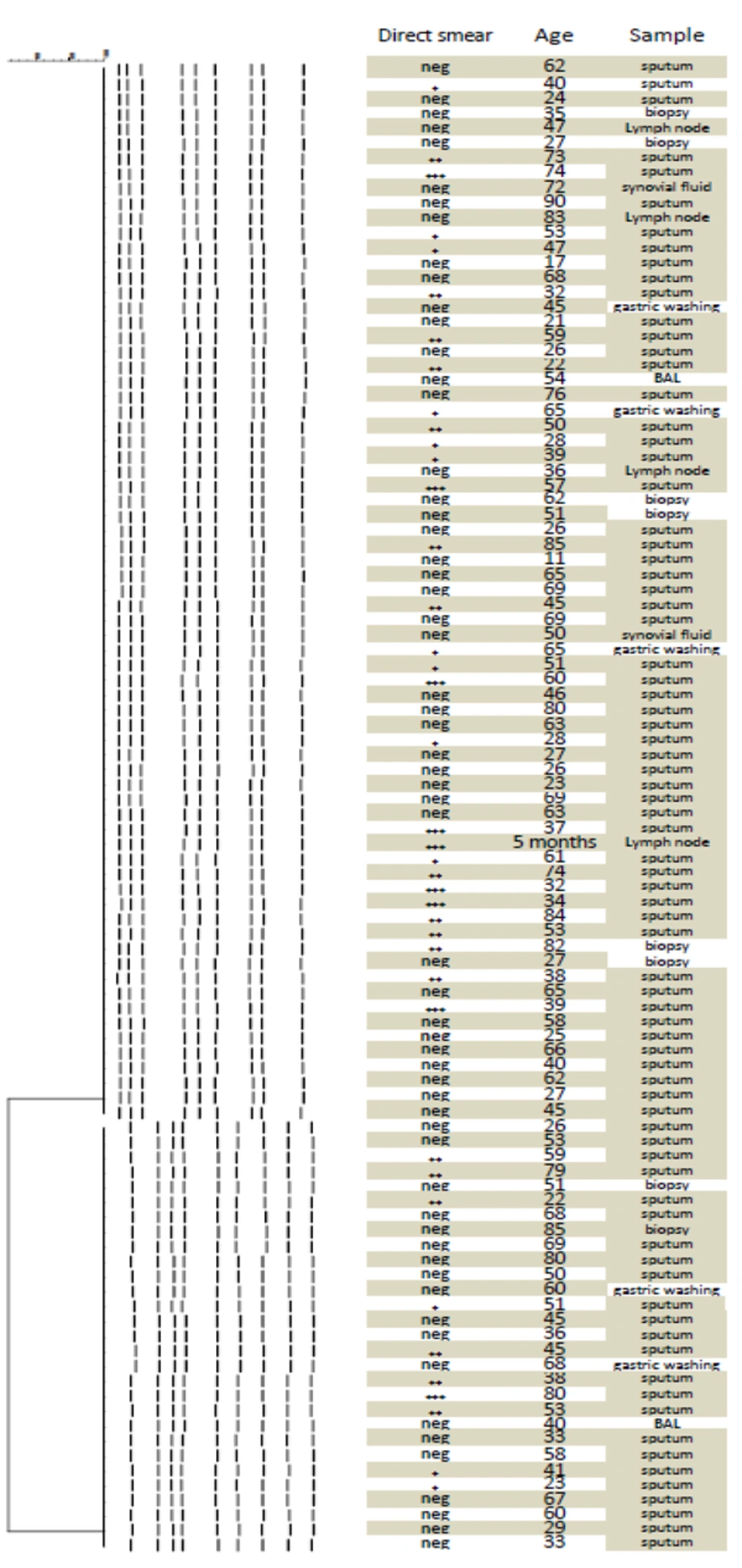1. Background
Despite all medical care, Mycobacterium tuberculosis is one of the most important human pathogens and death factors known. In most countries, rapid contagion of M. tuberculosis and multidrug resistant mycobacteria (MDR), which are resistant to isoniazid and rifampin, are considered as cautions for tuberculosis (TB) controlling programs (1). In recent years, the increase in immigration rates, emerging of drug-resistant strains, and HIV co-infection with TB, especially in developing countries, have led to precise and in-time diagnosis of TB. Therefore, finding out how these are spread and transferred is of high importance (1, 2). For these reasons, several molecular typing methods including pulsed field gel electrophoresis (PFGE) have been taken into account for epidemiological studying of TB.
The classification of M. tuberculosis isolates is essential for taking the spread of TB under control. Phenotypic methods such as phage-typing have been applied to separate mycobacterial species, but they have not been useful in molecular epidemiology studies. Molecular techniques based on bacterial genome have been more practical in genotyping studies of mycobacterial isolates (3). In PFGE, the whole bacterial genome is used for enzymatic digestion and finding clonal similarities, which provides us useful information on controlling the spread of the disease (4). In some cases, using PFGE genotyping method for genetic relatedness of mycobacterial isolates has more advantages than IS6110-restriction fragment length polymorphism (RFLP), because the last method depends on the copy number of the IS6110 sequence in the isolates and it is not effective for isolates with less than six IS6110 copies in their genomes. On the other hand, PFGE method does not have this limitation and using the entire genome of the organisms instead of focusing on short repeated elements is more beneficial (5, 6).
In PFEG, the intact bacterial genome is digested by special restriction enzymes. Having been given the fragment patterns and genetic diversity of the strains, we could have a standard and powerful instrument to genotype the M. tuberculosis isolates (4, 6). The resultant information on the analysis of this method is practical for monitoring the characteristics of available isolates, representing strain similarities in an area, detecting contamination resources, and designing programs to control pathogenic factors. Several restriction enzymes including XbaI, AseI, DraI, SpeI were used in PFEG method to digest TB bacterial genomes. XbaI enzyme recognizes less than 10 digestion sites per 106 bp in average and digests 40 - 50 kb DNA pieces which are not supportable and moveable by common gel electrophoresis, whereas in PFEG, the digested genome is separated easily by alternative changes in the electrical field (3, 4).
2. Objectives
Application of TB genotyping in a surveillance program is highly important. The present study was conducted to monitor the genetic diversities of M. tuberculosis isolated from patients in the Mycobacteriology Department of Pasteur Institute in, Tehran, Iran, during 2010 - 2011.
3. Materials and Methods
3.1. Bacterial Isolation and Identification
Comprehensive information of 100 patients referred to the Mycobacteriology Department of Pasteur Institute was gathered during 2010 - 2011. The information on gender, age, nationality, HIV infection and close contact with infected or carrier people were questioned. Direct smears of all the samples were stained by Ziehl-Neelsen technique to show acid-fast bacilli existence. After decontamination by N-acetyl-L-cysteine-sodium hydroxide, the samples were cultured in Lowenstein-Jensen agar and incubated in 37°C for two months and the growth results were monitored (7). All the positive cultures that were suspicious to M. tuberculosis were tested by several standard methods including niacin test, catalase activity (22°C and 68°C), nitrate reduction, thiophen-2-carboxylic acid hydrazide (TCH) sensitivity and pigment production (7).
3.2. Antibiotic Sensitivity Tests
The antibiotic sensitivity tests of M. tuberculosis isolates to rifampin (Sigma, USA) (40 μg/mL), isoniazid (Sigma, USA) (0.2 μg/mL), ethambutol (Sigma, USA) (2 μg/mL), kanamycin (Sigma, USA) (20 μg/mL), streptomycin (Sigma, USA) (4 μg/mL) and ethionamide (Sigma, USA) (20 μg/mL) were determined by proportional method using standard guidelines (8).
3.3. Genus and Species Polymerase Chain Reaction
All 100 M. tuberculosis isolates that were confirmed by genus and species PCR reactions were analyzed. Chromosomal DNA of all M. tuberculosis isolates was extracted using a silica gel column system high pure PCR template preparation kit (Roche, Germany). The extracted DNA samples were electrophoresed on 0.8% agarose gel and stained by ethidium bromide. The separated DNA bands were studied under the light of UV transilluminator. PCR reaction with specific primers in the following measurements with a total volume of 25 µL was performed to confirm M. tuberculosis isolates. The primer sequences were F: 5’-ATGCGGGCGTTGATCATCGTC-3’ and R: 5‘-CGGTGTGCCGGAGAAGCGC-3’. The PCR mixture included 2.5 μL PCR 10x buffer, 1.5 mM MgCl2, 200 μM dNTPs = 30 pmol primer-F, 30 pmol primer-R, 2 unit Taq DNA polymerase and 5 μL DNA. The amplification was accomplished in 95°C for 12 minutes, 35 cycles in 94°C for one minute, 64°C for one minute, 72°C for one minute, and final extension in 72°C for five minutes (9). The amplified 185 bp fragments were assessed by electrophoresis on 1.5% agarose gel and in 80 V for about one hour and stained by ethidium bromide.
3.4. Pulsed Field Gel Electrophoresis
Loop full colonies of 100 M. tuberculosis isolates with confirmed results in species identification with PCR were taken and inactivated in 200 µL distilled water in 80°C for an hour. They were centrifuged in 4000 rmp for 15 minutes, their sediments were rewashed by 1.5 mL Tris-EDTA (TE) buffer and solved in 1.5 mL TE buffer (10, 11). Afterwards, an equal volume of the given bacterial suspension was mixed with 1.5% InCert agarose and 10 µL lysozyme (10 mg/mL) (Sigma, USA) and poured in two molds. Two prepared plaques were incubated in 1.5 mL lysis buffer (containing 150 µL lysozyme, 1.5 mL TE buffer and 5 µL RNase A) in 37°C for 24 hours. To eliminate proteins, the mixtures were incubated in 1.5 mL ESP buffer (0.5 mM EDTA, 1.5 mL sarcosil 10%, 1 mg/mL proteinase K) (Sigma, USA) in 55°C for 48 hours. Finally, they were washed five times with TE buffer to be prepared for enzymatic digestion (11).
At the pre-digestion stage, the prepared plaques were washed twice in deionized water and were incubated by 100 µL enzymatic buffer at room temperature for an hour. Half of each agarose plaque was incubated with 100 μL enzymatic buffer and 6 μL XbaI (Roche, Germany) in 37°C for 24 hours. To perform PFGE, CHEF-DR III apparatus was programmed to replace electric fields per 0.5 to 10 seconds in 16 hours at the first switch time and per 10 to 17 seconds in four hours at the second switch time to move the digested DNA bands. The device temperatures, voltages and field angles were set at 14°C, 6 V/cm2 and 120°C, respectively (5, 6). Agarose gel was stained by ethidium bromide and monitored by a transilluminator device. Finally, PFGE patterns were analyzed by GelCompar II software.
4. Results
A total of 100 clinical M. tuberculosis isolates were isolated from 46 females and 54 males, aged five months to 86 years old, attending the Mycobacteriology Department of Pasteur institute of Iran. All the patients were Iranian except one Afghan man and they all lived in cities. Out of all the patients, 42% had positive direct smears.
4.1. Antibiotic Sensitivity Tests
The frequencies of resistance to ethionamide, streptomycin, ethambutol, rifampin, kanamycin and isoniazid were 61%, 37%, 26%, 23%, 21%, and 13%, respectively. Totally 71% of the samples were resistant to at least one drug, and four MDR isolates were detected.
4.2. Species-Specific Polymerase Chain Reaction
The result of the PCR reaction was considered positive, when 185 bp fragments were observed among all the studied isolates of M. tuberculosis (Figure 1).
4.3. Pulsed Field Gel Electrophoresis
Digestion patterns of the isolates were analyzed by GelCompar II software in comparison with Salmonella choleraesuis serotype Braenderup H9812 as the molecular weight marker (Figure 2). The given dendrogram of genetic similarities represented two common types (Figure 3); common type A (pulsotype A) was the most prevalent one comprising 71 isolates and common type B (pulsotype B) included the other 29 isolates.
5. Discussion
TB is a chronic infectious disease caused by M. tuberculosis (7). Before using molecular typing researches, it was hard to detect the infection resource. As M. tuberculosis gets transferred by aerosol particles by infected respiratory secretions, it would remain a hidden infection without any noticeable sign (5, 7). Another significant point taken into account is the role of intercity immigration in transferring TB. It is most likely that the disease spreads in highly populated areas when people commute between workplace and home in suburban areas while they are infected by TB, being considered as carriers (1). The results extracted from our studied patients’ demographic questionnaires showed that approximately 90% of patients commute in Tehran and its suburbs such as Karaj, Shahriar, Shahr-e-Ray, Islamshar, and Robat-Karim. Therefore, controlling the TB infection through human travel is highly important in preventing the spread of TB.
In a study by Asgharzadeh et al. (12), among 100 patients, 71 were sensitive to streptomycin, ethambutol, isoniazid, rifampicin, and their resistance to streptomycin, isoniazid and rifampicin were 15.2, 9.5, and 5.7%, respectively. Our recent research in comparison showed a rise-up in the number of drug-resistant and MDR isolates, which explains the necessity of using rapid recognition of MDR strains and controlling the transference of the disease. Using molecular methods to represent the spread of M. tuberculosis isolates that show resistance to drugs is important. Moreover, simultaneous application of molecular techniques and the results of antibiotic resistance test is a precise and rapid method to prevent the spread of different types of M. tuberculosis isolates (10, 13). Distinguishing phenotypic and genotypic similarities to recognize how a disease spreads in an area, understanding its pathogenic agents and the cure of the disease are extremely important factors (10, 14).
Phenotypic characters may change under special circumstances such as place and time. Hence, studying the bacteria according to given information from genomic DNA is recommended to acquire reliable and clear data (14, 15). We applied PFGE to represent genetic diversities of M. tuberculosis isolates. Comparison of the restriction patterns of 100 M. tuberculosis isolates with XbaI restriction enzyme revealed only two common pulsotypes. Both types mostly occurred in Tehran and its suburbs which can rapidly be disseminated and must be considered to control this infection. The high incidence of MDR isolates (75%) in common type B should be under closer inspection during surveillance programs to prevent the spread of MDR-TB in future.
The limited patterns of DNA fragments from enzymatic digestion showed that restricted sites of XbaI were protected in studied M. tuberculosis isolates. Zhang et al. (5), showed that XbaI and SpeI were more powerful in distinguishing M. tuberculosis isolates than AseI, DraI. On the other hand, similar to the study by Feizabadi et al. (10), reporting that DraI created more polymorphism than XbaI, the low genetic diversity among our studied isolates may have been caused by the presence of the conserved area and the absence of mutations on the mycobacterial DNA for XbaI restriction sites. In molecular epidemiology studies of infectious disease, applying different molecular typing methods increases the discrimination power and provides more information about the studied population up to 21 - 35% (16, 17). Therefore, controlling the TB infection through monitoring the incoming travelers is necessary.


